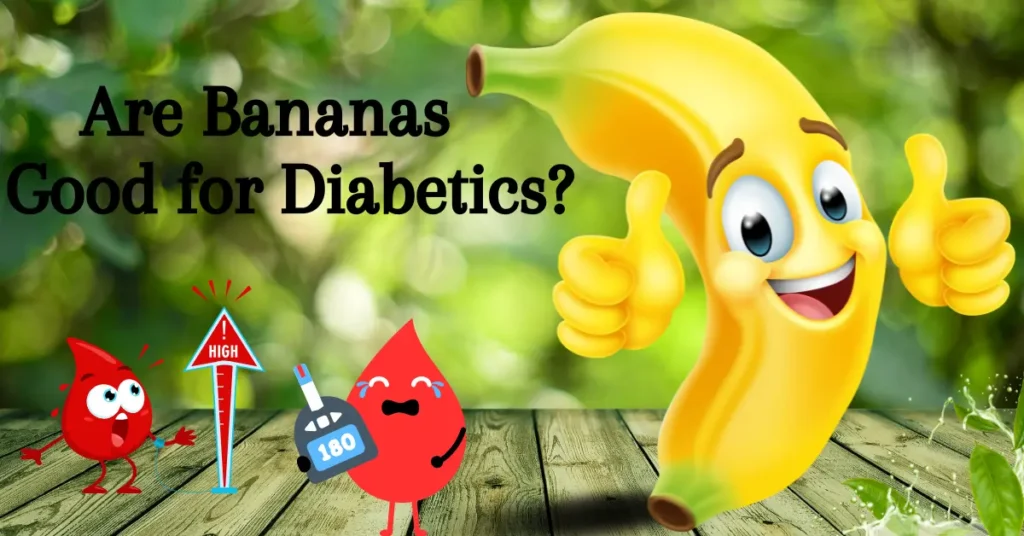When you’re living with diabetes, even simple food choices can feel overwhelming. A question many people with diabetes often ask is: Are bananas good for diabetics? In this simple, no-stress guide, we’ll break it all down — so you can enjoy your food with confidence, not confusion.
Because they’re sweet, bananas often get unfairly labeled as “unsafe” — but the truth isn’t that black and white. Managing diabetes isn’t about avoiding everything you love, it’s about finding balance.
In this article, we’ll clear the confusion and help you understand whether bananas can still have a place in your diet — without guilt or guesswork.
How the Glycemic Index of Bananas Affects Blood Sugar in Diabetics?
For people with diabetes, the glycemic index (GI) of foods plays an important role in managing blood sugar. GI tells us how quickly a food raises blood glucose levels. Bananas fall in the moderate GI range, but the number changes depending on how ripe the banana is.As bananas ripen, their natural sugar content increases, which slightly raises their GI. This means a green banana will affect your blood sugar more slowly than a fully ripe or overripe one.
| Ripeness | Look | GI Range | Blood Sugar Effect |
|---|---|---|---|
| Unripe (Green) | Firm, green peel | 42–48 | Slow sugar release, more resistant starch |
| Ripe (Yellow) | Bright yellow, soft texture | 50–55 | Moderate sugar release, safer in portions |
| Overripe (Spotted) | Brown patches, very soft | 60+ | Faster sugar release, more caution needed |
Choosing the right level of ripeness — and eating bananas in controlled portions — can help you enjoy them without worrying about sugar spikes. For best results, pair bananas with a protein or healthy fat, like a handful of nuts or a spoon of peanut butter, to keep your blood sugar more stable.

Nutritional Value of Bananas: What Diabetics Need to Know
Bananas are more than just a sweet and convenient snack — they’re packed with important nutrients that can support overall health, even for people with diabetes. On average, one medium-sized banana (about 118 grams) contains around 105 calories, 27 grams of carbohydrates, and about 14 grams of natural sugar.
What makes bananas more balanced is their 3 grams of fiber, which helps slow down sugar absorption in the body and improves digestion. They also offer around 1.3 grams of protein, making them slightly more filling than other sugary fruits. Additionally, bananas are a great source of potassium (about 422 mg) — a mineral that helps maintain healthy blood pressure, and vitamin B6, which supports brain health and energy metabolism.
For diabetics, the real benefit lies in the combination of fiber and nutrients, which can help manage blood sugar when bananas are eaten in the right portion. They’re low in fat, contain no cholesterol, and have zero added sugars — all of which makes them a natural, whole-food choice when consumed mindfully.
Nutritional Value of a Medium Banana (118g)
| Nutrient | Amount | Why It’s Useful |
|---|---|---|
| Calories | 105 kcal | Energy boost without added sugars |
| Carbohydrates | 27 grams | Fuel for the body — watch the portion size |
| Natural Sugars | 14 grams | May raise sugar levels — pair wisely |
| Fiber | 3 grams | Slows sugar absorption, supports digestion |
| Protein | 1.3 grams | Keeps you fuller, stabilizes energy |
| Fat | 0.3 grams | Minimal — heart-friendly |
| Potassium | 422 mg | Helps control blood pressure |
| Vitamin B6 | 0.4 mg | Supports energy metabolism & brain health |
| Magnesium | 32 mg | Helps regulate blood sugar |
| Vitamin C | 10.3 mg | Boosts immunity, acts as antioxidant |
Interested in how Ayurvedic approaches fit into diabetes care? Visit our Diabetes Care section for more practical insights and remedies.
Should Diabetics Eat Bananas? Here’s What the Nutritional Value Tells Us
When researching “Are bananas good for diabetics? Full guide to eating right” topics, one thing becomes clear: it’s not about avoiding bananas but about understanding how they fit into your overall diet.
Looking at the nutritional profile of bananas, it’s clear that they can be part of a balanced diabetic diet — but portion control is key. A medium banana is low in fat, contains no added sugars, and is packed with nutrients like fiber, potassium, and vitamin B6, which support heart health and help maintain energy levels. The natural sugars in bananas do raise blood sugar slightly, but the fiber content helps slow down that process, making it easier for your body to handle.
So, if you’re living with type 2 diabetes or managing your blood sugar, you don’t need to completely avoid bananas. Just make sure you’re eating them in moderation — ideally a small or medium banana — and pair them with a protein-rich snack like nuts, yogurt, or a boiled egg to balance the sugar load.
In simple terms, bananas are not harmful for diabetics — as long as you’re mindful about when and how much you eat. Instead of cutting them out, it’s better to enjoy them smartly as part of a healthy, well-planned diet.
Conclusion:
Yes, diabetics can eat bananas — but in moderation and with mindful choices. Bananas offer valuable nutrients, but their natural sugar means portion size and ripeness matter.
Choosing a small or slightly unripe banana and pairing it with protein or healthy fat can help keep blood sugar stable. So, instead of avoiding bananas, just enjoy them smartly — as part of a balanced diabetic diet.




